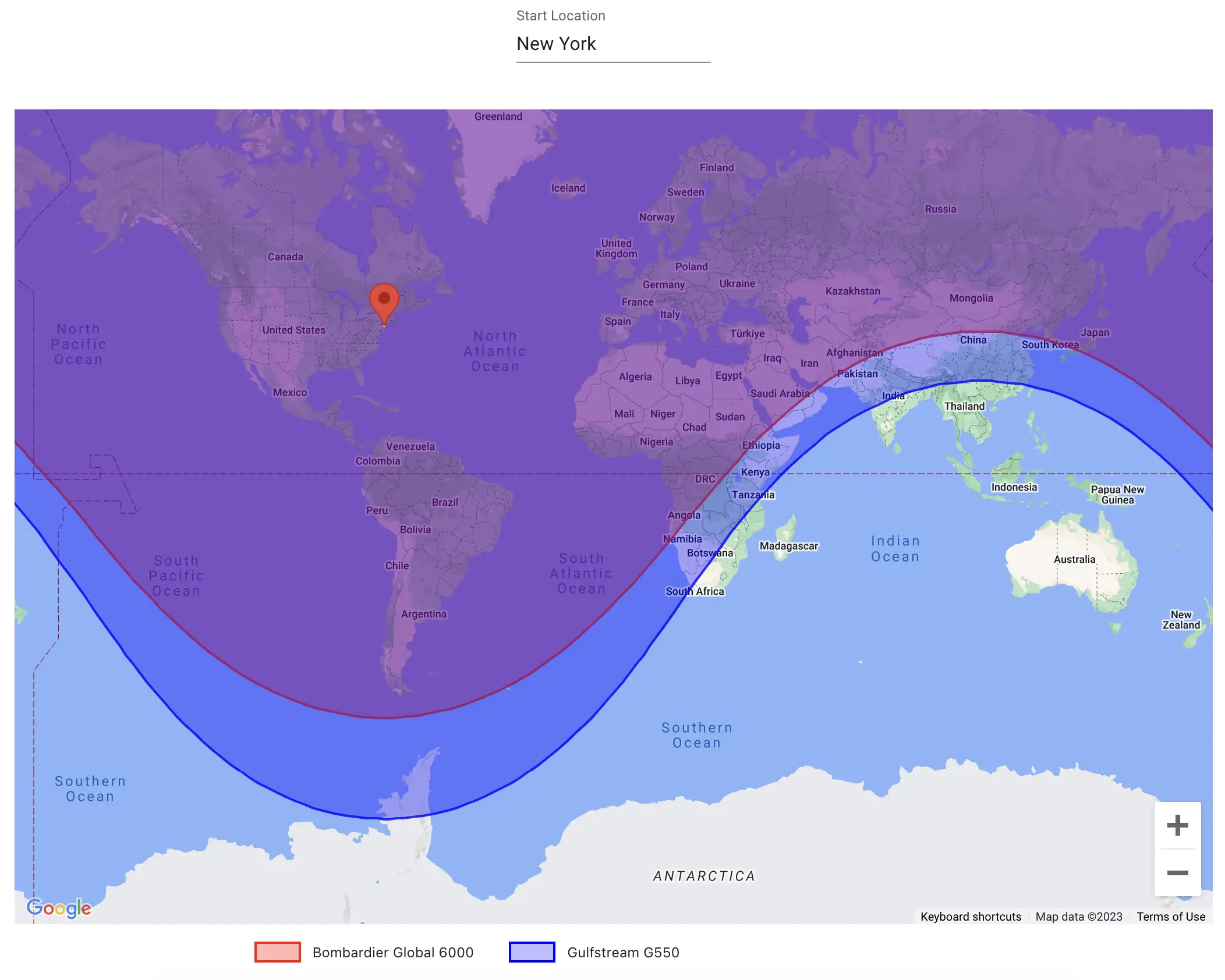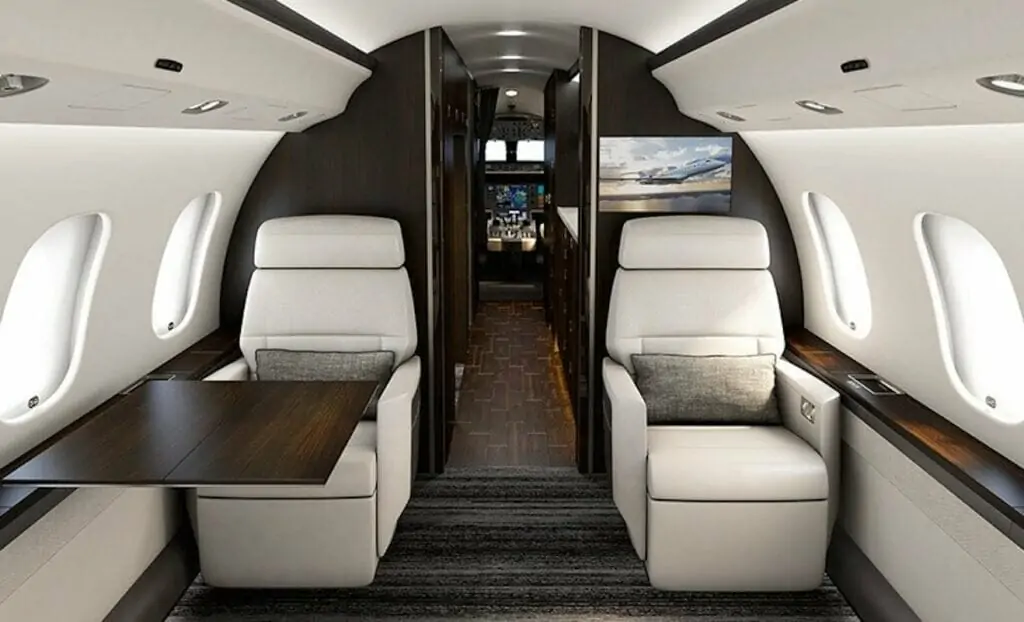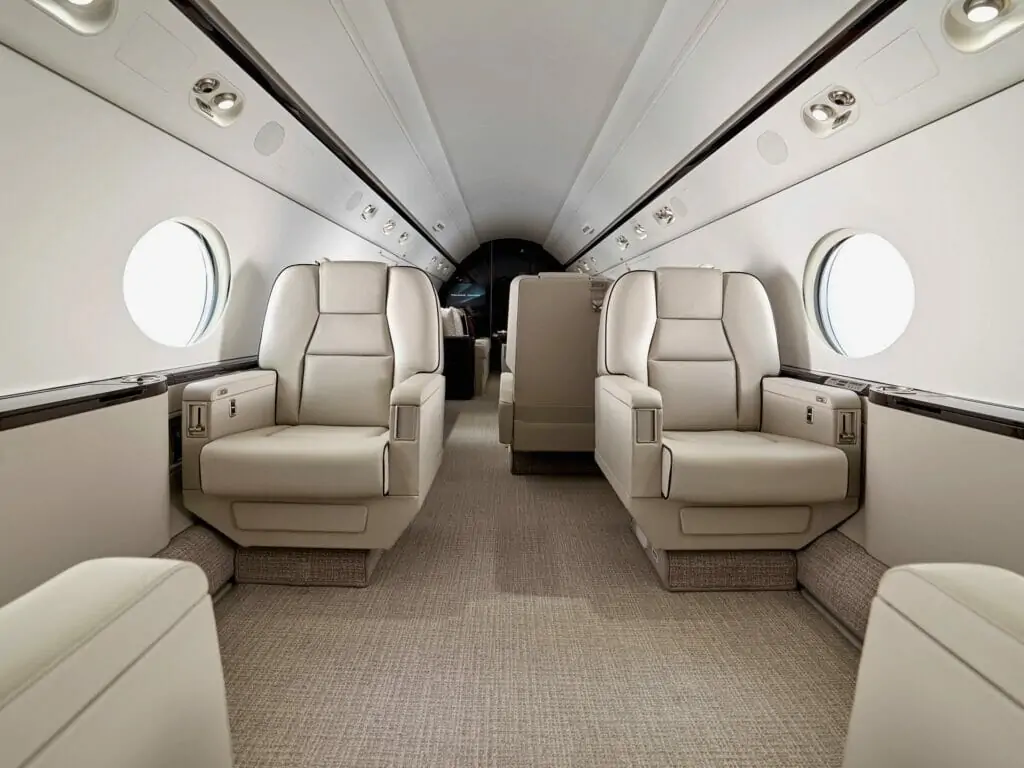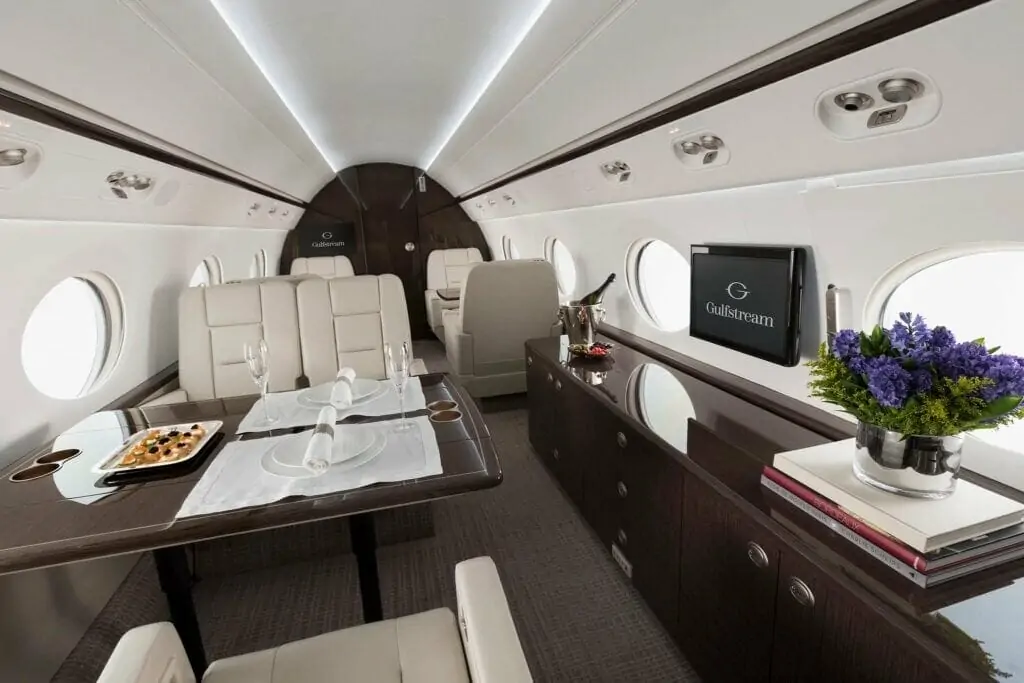The Bombardier Global 6000 and Gulfstream G550 are fierce competitors in the world of long-range private jets.
Both are targeting the same audience. As ever, there are customers who are loyal to the Global family and those who are loyal to Gulfstream aircraft.
However, does either one have an advantage that will convert the opposition to buy their aircraft?


Performance
First, let’s take a look at the performance of these two aircraft.
Both aircraft are powered by Rolls-Royce engines, with the Global 6000 utilizing the BR710-A2-20 model and the G550 employing the BR710 model.
When comparing the thrust output, the Bombardier Global 6000 has a total thrust output of 29,500 lbs (13,381 kg) with each engine producing 14,750 lbs (6,690 kg) of thrust.
On the other hand, the Gulfstream G550 has a slightly higher total thrust output of 30,770 lbs (13,962 kg), with each engine generating 15,385 lbs (6,981 kg) of thrust.
Despite the additional thrust of the G550 the Global 6000 is capable of cruising at a higher speed.
In terms of cruise speed, the Global 6000 has a high-speed cruise of 513 knots (949 km/h) and a long-range cruise of 471 knots (872 km/h).
The G550, however, has a slightly lower high-speed cruise of 488 knots (904 km/h) and a long-range cruise of 459 knots (850 km/h).
A higher cruise speed offers the benefit of reduced travel time, allowing passengers to reach their destinations faster. While the difference in cruise speed is relatively minimal passengers will still have the chance of arriving sooner at their final destination.
Both aircraft have a maximum altitude of 51,000 feet (15,545 m) and an initial cruise altitude of 41,000 feet (12,497 m).
A higher maximum altitude provides several advantages, such as smoother flights due to less air turbulence, as well as increased fuel efficiency since the air is thinner at higher altitudes.
When examining the rate of climb, the Global 6000 climbs at a rate of 3,300 feet per minute (1,006 m/min), while the G550 has a slightly faster rate of 3,740 feet per minute (1,140 m/min).
A faster rate of climb allows the aircraft to reach its cruising altitude more quickly, ensuring a smoother and more comfortable flight for passengers.
Fuel consumption is another important factor to consider. The Bombardier Global 6000 has a fuel burn of 470 gallons per hour (1,780 liters per hour), while the Gulfstream G550 consumes 358 gallons per hour (1,355 liters per hour).
Choosing an aircraft with a lower fuel burn figure can result in significant cost savings. Assuming that Jet A fuel costs $6 per gallon, and both aircraft fly 300 hours per year, the G550 would save $201,600 per year compared to the Global 6000.
Range
The naming of the Global family of aircraft is an interesting one. In some circumstances, like with the Global 6000, the number relates to the maximum range. However, in other cases, such as the Global 7500, it does not.
As mentioned, the Global 6000 has a range of 6,000 nautical miles (11,112 km).
In comparison, the G550 offers a slightly longer range of 6,750 nautical miles (12,501 km).
It is important to note that these range figures represent the best-case scenario and can be affected by various factors.
One factor that can influence the range is the weight of the aircraft, including passengers, baggage, and fuel. A heavier aircraft may require more fuel to travel the same distance, thereby reducing its overall range.
Weather conditions, such as headwinds or tailwinds, can also impact the range, as strong headwinds can increase fuel consumption, while tailwinds can help extend the range.
Additionally, the altitude at which the aircraft is flying plays a role in determining its range, as higher altitudes generally result in decreased air resistance and improved fuel efficiency.
Looking at the range map below we can see that both aircraft are capable of cruising non-stop from New York to all of North America, South America, Europe, and large parts of Africa and the Middle East.
However, the G550 is able to go that little bit further from New York, being able to fly non-stop to parts of India, Pakistan, and South Africa.

Ground Performance
Ground performance is a crucial aspect when comparing private jets, as it directly impacts the take-off and landing capabilities of each aircraft.
The G550 requires less runway to get into the sky with a take-off distance of just 5,910 feet (1,802 meters) compared with the minimum take-off distance of 6,476 feet (1,974 meters) for the Global 6000.
A shorter take-off distance means that more airports can be accessed by the aircraft.
However, it is important to note that these figures are the absolute minimum runway length requires. Therefore, real-world figures will vary when you start loading these aircraft with fuel, people, and baggage.
Having said that the difference in take-off distance between the Global 6000 and G550 is significant. A difference of more than 500 feet will likely be noticeable in the real-world.
Landing distance is not quite as important as the minimum take-off distance as it is almost always shorter than the take-off distance. And, in almost every situation imaginable, wherever an aircraft lands it must also take-off.
Therefore, the Global 6000 having a shorter landing distance of 2,236 feet (682 meters) compared with 2,770 feet (844 meters) for the G550 is not as big an advantage as the shorter take-off distance of the G550.
It is important to note that these ground performance figures represent the best-case scenario and may be influenced by a variety of factors.
Interior Dimensions
The interior dimensions of an aircraft play a significant role in passenger comfort and overall flying experience. When comparing the Bombardier Global 6000 and Gulfstream G550, there are notable differences in their respective cabin sizes.
The Gulfstream G550 has a longer cabin measuring 50.10 feet (15.27 meters) versus 43.24 feet (13.18 meters) for the Global 6000.
A longer cabin offers several benefits to passengers, such as increased legroom, more seating options, and additional space for amenities like conference tables or entertainment areas. This can enhance the overall comfort and functionality of the aircraft during long flights.
When it comes to the width of these aircraft the Global 6000 outperforms the G550 with a interior cabin width of 7.91 feet (2.41 meters) and 6.99 feet (2.13 meters) respectively.
A wider cabin provides passengers with more elbow room, shoulder room, and personal space, contributing to a more comfortable and enjoyable flight experience.
And finally, cabin height. A taller cabin allows for more headroom. This, in turn, results in a more spacious feeling cabin but also makes it easier to move around the cabin during the flight.
Again, the Global 6000 demonstrates a taller cabin than the G550 with an interior height of 6.17 feet (1.88 meters) versus 6 feet (1.83 meters) for the G550.
Given the longer cabin of the G550, it will come as no surprise that it can accommodate more passengers than the Global 6000.
The Gulfstream G550 can hold a slightly larger number of passengers, with a maximum capacity of 19 and a typical configuration of 15 passengers.
In comparison, the Bombardier Global 6000 can accommodate up to 17 passengers in its maximum configuration and typically carries 13 passengers.
Interior
The inside of these two cabins has all the features that you would expect from two long-range business jets.
However, one area that is often overlooked when comparing private jets, especially when flying between time zones, is the cabin altitude.
A lower cabin altitude results in a more comfortable cabin and reduces the impact of jet lag.
When cruising at 51,000 feet the Global 6000 has a cabin altitude of 5,680 feet (1,731 meters). This is lower than the cabin altitude of 6,000 feet (1,829 meters) for the Gulfstream G550.
Therefore, it also will come as no surprise that the Global 6000 is able to maintain a sea-level cabin for longer, all the way up to 30,125 feet (9,180 meters).
In comparison, the Gulfstream G550 is capable of maintaining a sea-level cabin up to 29,200 feet (8,900 meters).
Bombardier Global 6000
Unsurprisingly the Global 6000 has a well-appointed interior. The interior has been designed to bring you the smoothest, most refreshing, and most productive experience possible from a business jet.
Thanks to the widest cabin in its class, more room is on offer than its nearest competitor. In Bombardier’s own words; “with outstanding width, higher armrests, and an impeccably shaped backrest, the new seats allow passengers to enjoy a delightful and inviting experience, ideally suited to long-distance travel. Whether you wish to work, rest or play, time will simply fly by as you sit back in this exceptional interior.”
The galley features hardwood flooring, seats sculpted to the human body, and elegantly designed lines. Featuring Bombardier’s cabin management system you can control the whole cabin from your fingertips. The ultra-fast and intuitive media bay allows you to watch films, live streams, and display documents on TV monitors.
Bombardier has even developed the cabin management system to be controllable from your mobile device (iOS and Android). The media bay onboard allows you to connect a host of devices, such as game consoles, Blu-ray players, and digital media players.
The 6000 has the fastest available in-flight internet connectivity worldwide based on Ka-band technology. Join video conferences, stream films, and even online games. Bombardier offers a variety of data packages. These packages allow you to find the right speed for your needs. Ka-band technology is the fastest in the air (up to 15 Mbps). Additionally, Ka-band provides the best coverage and reliability.
At the rear of the aircraft, you will find the stateroom. This adds “a sense of tranquility” with large windows providing ample natural light. The stateroom features a full-berth divan, a spacious wardrobe, independent temperature control, and a lavatory area.
When you are flying above the clouds on a long flight it is imperative that you eat well. The large fully-equipped galley guarantees this. Substantial storage capacity and extensive work surfaces allow for greater meal capabilities.
Finally, ensure that your crew is always performing at their best. A dedicated crew rest area will take care of this.
If you would like to configure your own Global 6000 then simply head over to Bombardier’s configurator.
Bombardier Global 6000



Gulfstream G550



Gulfstream G550
The G550 has a large cabin that is capable of sleeping up to eight passengers. One of the most notable features of all Gulfstream’s are the large, oval-shaped windows.
These windows are larger than the competition and the G550 features 14 Gulfstream Signature Oval Windows throughout the cabin, making the cabin feel even larger and helping boost wellness through the abundance of natural light.
Despite the length of time that the G550 has been in service it still features all the modern technology that one would expect from a private jet. All seats feature a personal audio/visual display and cabin settings are able to be controlled through a smartphone app, such as the window shades, the cabin temperature, video input, cabin audio, and flight information.
When configuring the aircraft everything is bespoke to the customer with a wide range of cabin configurations available (see below). You can option forward or aft galley configurations, with or without a crew compartment, and up to four living areas.
If you want a rice cooker in the galley this can be optioned. As standard, the G550 features a wireless network, satellite communication, an Iridium phone, and a fax/printer.
Charter Price
When comparing the charter cost per hour of the Bombardier Global 6000 and the Gulfstream G550, there is a slight difference between the two aircraft.
The Bombardier Global 6000 has an average charter cost of $8,000 per hour, while the G550 has a marginally lower hourly rate of $7,650.
It is important to consider that the cost to charter a private jet can be influenced by various factors.
One such factor is the aircraft’s age, as newer jets may command higher charter rates due to their advanced features and updated technology.
Another factor to consider is the flight distance, as longer flights may lead to higher costs due to increased fuel consumption and potential overnight fees for the crew.
Lastly, demand and availability can also impact charter rates, with prices potentially varying depending on the time of year, specific location, and overall market conditions.
Purchase Price
When new, both the Global 6000 and the G550 have a new list price of $62,000,000.
However, one of these aircraft holds its value better than the other (it’s the G550 that will lose less value).
The Bombardier Global 6000 has an annual depreciation rate of 9.76% compared with just 5.6% for the G550. When dealing with multi-million dollar aircraft, just a few percentage points can mean the difference between millions of dollars saved in value.
If we take a 2020 model aircraft, for example, a Global 6000 will cost $31.2 million compared with $33 million for a G550 of the same age.
Then, if you were to buy each of these aircraft today and hold on to them for 3 years the Global 6000 would be estimated to have a resale value of just under $23 million versus just under $28 million for the G550.
Based on these figures, the Bombardier Global 6000 is expected to lose more money over the ownership period in terms of actual dollar amounts when compared to the Gulfstream G550.
There are several factors that can influence the depreciation rate of a private jet. For example, maintenance of the aircraft, new aircraft competition, damage history, and market demand will all impact depreciation rates. However, generally speaking, Gulfstream aircraft hold their value far better than the competitors,
Summary
In summary, both the Bombardier Global 6000 and the Gulfstream G550 are exceptional private jets, offering impressive performance, range, and comfort.
The Global 6000 boasts a wider and taller cabin, a slightly lower maximum cabin altitude, and the ability to maintain a sea-level cabin at a higher altitude.
On the other hand, the G550 features a longer cabin, a shorter take-off distance, and a lower hourly charter cost.
Determining which aircraft is better ultimately depends on the specific needs and preferences of the potential buyer.
The Bombardier Global 6000 may be the ideal choice for those who prioritize cabin comfort and a lower cabin altitude, which can be beneficial during long-haul flights.
Conversely, the Gulfstream G550 may be a better option for those who require a longer cabin, greater flexibility in take-off distances, and more competitive charter costs.






